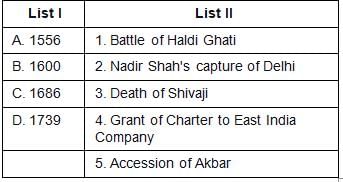Test: Class 12 History NCERT Based- 2 - UPSC MCQ
30 Questions MCQ Test History for UPSC CSE - Test: Class 12 History NCERT Based- 2
Consider the following statements:
1. Henry Bloachman was the first scholar to translate all 3 volumes of Ain-e-Akbari into English.
2. Henry Bloachman was associated with the Asiatic Society of Bengal.
Which of the following is/are correct?
In which year the Third Battle of Panipat was fought?
Regarding Mughal Administration, what was the role of Qanungos?
In the context of the Mughal Empire, who is Mutasaddi?
Consider the following statements in the context of classification of land under Mughal Emperor Akbar:
1. Polaj is land which is annually cultivated for each crop in succession and is never allowed to lie fallow.
2. Chachar is land that has lain fallow for three or four years.
Which of the following is/are incorrect?
In medieval India, Mansabdari system was introduced for:
The medieval Indian writer who refers to the discovery of America is:
Regarding the role of Jati panchayats, consider the following statements:
(a) Jati panchayats arbitrated civil disputes between members of different castes.
(b) In most cases, except in matters of criminal justice, the state respected the decisions of jati panchayats.
Which of the following is/are correct?
Match List-I with List-II and select the correct answer using the codes given below the lists:

Consider the following statements:
1. According to the Sunset Law, if payment did not come in by sunset of the specified date, the zamindari was liable to be auctioned.
2. A low demand was imposed in the 1790s, a time when the prices of agricultural produce were depressed.
Which of the following is/are not correct?
Consider the following statement:
1. Collectors emerged as an alternative of Zamindars in respect to authority.
2. Zamindars collected rent with the help of an officer 'Amlah'.
Which of the following statements is correct?
Which of the following is correct about Aftermath of the Santhal Revolt?
For what purpose British East India Company hire Francis Buchanan?
In which year ryots of Supa rose to revolt?
Why British government? did not expand Permanent Settlement beyond Bengal?
In which year the Deccan Riots Report was present to the British parliament?
Consider the following statements regarding the early years of the East India Company establishment in India:
(1). The colonial rule was first established in The Bengal.
(2). In the beginning, the earliest attempts were made to reorder rural society and establish a new regime of land rights and a new revenue system.
(3). The Permanent Settlement had come into operation in 1793. The East India Company had fixed the revenue that each zamindar had to pay.
Which of the following statement(s) is/are correct?
Consider the following statements regarding after the establishment of British East India Company in Bengal:
1. In 1797 there was an auction in Burdwan (present day Bardhaman) during which A number of mahals (estates) held by the Raja of Burdwan were being sold.
2. The Permanent Settlement had come into operation in 1793.
3. The estates of those who failed to pay were to be auctioned to recover the revenue.
Which of the following statement(s) is/are correct?
Consider the following statements:
1. According to limitation law loan bonds signed between moneylenders and ryots would have validity for only three years.
2. This law was meant to regulate the wealth of Jotedars.
Which of the following is/are correct?
Under the Permanent Settlement, 1893, the Zamindars are required to issue pattas to the farmers which were not issued by many of the Zamindars. The reason was:
After the Santhal Uprising subsided, what was/were the measure/measures taken by the colonial government?
1. The territories called 'Santhal Parganas' were created.
2. It became illegal for a Santhal to transfer land to a non-Santhal.
Choose from following options:
Under which one of the following systems of assessment, the British Government collected revenue directly from the farmers?
After Deccan Riots as a conciliatory measure, the Deccan Agriculturists Relief Act was passed in which year?
In which year the Cotton Supply Association was founded?
Who was the Governor General of Bengal when the Permanent Settlement was introduced in 1793?
Consider the following events: (Past prelims)
1. Indigo Revolt
2. Santhal Rebellion
3. Deccan Riot
4. Mutiny of the Sepoys
The correct chronological sequence of these events is:
Consider the following statements:
(1) As per customary norms the interest charged on loan should be half of the principal amount.
(2) By the 1770s, the rural economy in Bengal was in crisis, with recurrent famines and declining agricultural output.
Which of the following statement(s) is/are correct?
Consider the following statements:
1. As the Civil War ended in America, cotton production in America revived however Indian cotton exports to Britain increased due to its quality.
2. Ryots in Bengal always cultivated the land directly, but never leased it out to under-ryots.
Which of the following statement(s) is/are not correct?
|
112 videos|505 docs|173 tests
|




















